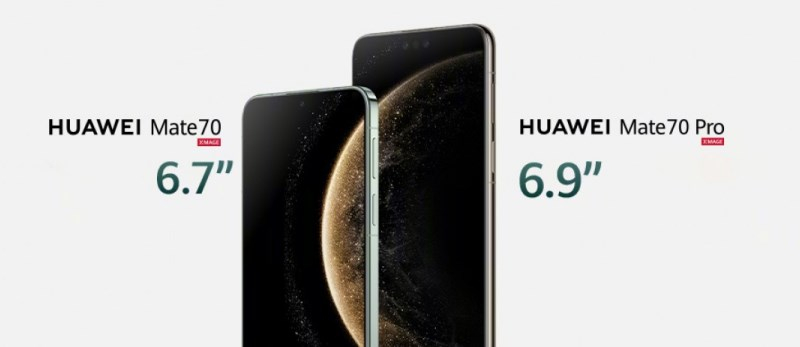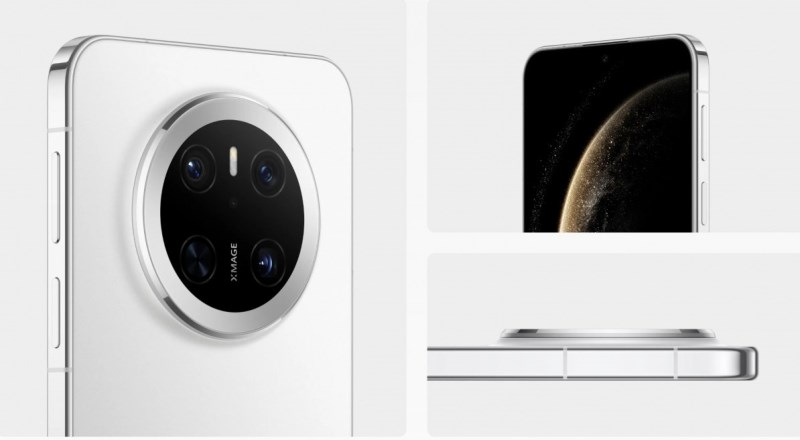Huawei introduced the flagships Mate 70 and Mate 70 Pro with spectral cameras and mysterious processors


Huawei has officially unveiled the flagship smartphones of the Mate 70 series, which includes four models – the advanced Mate 70 Pro+ and Mate 70 RS, as well as the basic Mate 70 and Mate 70 Pro. Each of the latest pair of new products has a bright LTPO OLED display, updated cameras and a proprietary chip.


Image source: GSM Arena
Mate 70 is the most compact and thinnest smartphone in the series (body thickness 7.8 mm). The developers equipped it with a 6.7-inch display with a resolution of 2688 × 1216 pixels and a variable refresh rate from 1 to 120 Hz. A panel with a peak brightness of 2500 cd/m² is used. The more advanced Mate 70 Pro received a 6.9-inch screen with a resolution of 2832 × 1316 pixels, a variable refresh rate from 1 to 120 Hz and a brightness of up to 2500 cd/m². In both cases, the screen is protected from mechanical damage by Kunlun Glass 2, and the body is made in accordance with the IP69 standard.


The Mate 70 has a 13-megapixel (f/2.4) wide-angle front camera with support for 4K video recording, while the Mate 70 Pro adds a 3D Depth sensor to the same 13-megapixel sensor to enable face unlock. The fingerprint scanner is integrated into the power button on the side of the case. This button also provides smart controls, such as activating the flash, launching an AI assistant, or putting the device into silent mode.
The main camera of each of the new products is based on a 50-megapixel sensor with a variable aperture from f/1.4 to f/4.0 and support for optical image stabilization. Also common to the two models is a 40 MP wide-angle module (f/2.2) with a viewing angle of 120º. In addition to this, the Mate 70 has a 12 MP (f/3.4) periscope lens with 5.5x optical zoom, while the Mate 70 Pro has a 48 MP (f/2.1) periscope lens with 4x zoom. In both cases, 4K video recording is supported.
An interesting innovation was the appearance of a spectral image sensor in the center of the main camera block. Unlike the traditional RGGB color sensors in current Huawei or RYYB smartphones used in the past, spectral modules can collect more color data. This allows for improved color reproduction overall. The sensor works in tandem with other sensors to provide natural color reproduction even in difficult light scenes.
As before, Huawei does not disclose information about which microprocessor is the basis of the Mate 70 series smartphones. According to rumors, this is a self-developed Kirin 9100 chip. It is assumed that it is manufactured using the 6 nm process technology at the facilities of the Chinese SMIC and has one main Cortex core -X1 with a frequency of up to 2.67 GHz. Both smartphones are available in versions with 12 GB of RAM and 256 GB, 512 GB or 1 TB storage. The Mate 70 is powered by a 5300 mAh battery with support for fast wired charging up to 66 W and wireless charging up to 50 W. The Mate 70 Pro has a 5500 mAh battery with support for wired charging up to 100 W and wireless charging up to 80 W.
Both smartphones run Huawei’s proprietary software platform HarmonyOS 4.3, and will be updated to Harmony Next in the future. As for the price, the Mate 70 costs from $757 (12 GB RAM and 256 GB ROM) to $965 (12 GB RAM and 1 TB ROM). The cost of the more advanced Mate 70 Pro starts at $895 (12 GB and 256 GB ROM) and ends at $1100 (12 GB RAM and 1 TB ROM).
Recent Posts
Nissan Leaf EV to Become NACS-Ported Compact Crossover in Third Generation
Nissan Leaf can rightfully be considered a long-liver of the electric car market, since the…
OpenAI expects to more than triple its revenue this year and then double it next year.
OpenAI, the market leader in generative artificial intelligence systems, remains nominally a startup, its financial…
OpenAI Decides to Hold 4o Image Generation Launch for Free Users
OpenAI has been forced to delay the release of ChatGPT's built-in image generator for free…
1440p and 240Hz for just $200: Xiaomi updates the 27-inch Redmi G27Q gaming monitor
Xiaomi continues to update its Redmi G27Q gaming monitor every year. The model was first…
Beware, Android is shutting down: OS development will cease to be public, but there is no reason to panic
Android device makers can significantly customize the look and feel of the operating system, but…
Fake GeForce RTX 4090s with RTX 3090 chips have started popping up in China — craftsmen are even changing the GPU markings
In China, scammers have started selling GeForce RTX 3090 graphics cards, passing them off as…